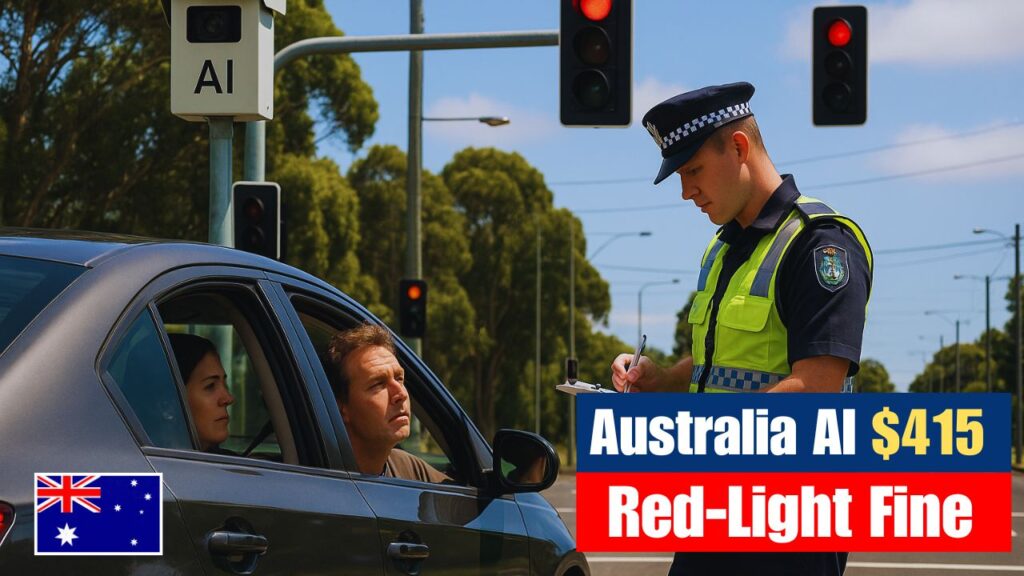Australia Introduces Rolling Red Fine – Australia is introducing a major road safety reform from 30 November, bringing in a new $415 rolling-red fine supported by advanced AI red-light cameras. This nationwide update aims to reduce dangerous intersection behaviour by detecting drivers who creep forward or move through a red signal before it turns green. With AI-powered monitoring now expanding across multiple states, Australian drivers are being urged to follow traffic rules closely to avoid penalties. The new enforcement system is expected to increase road safety while ensuring faster and more accurate detection of violations compared to traditional cameras.

AI Red-Light Fine Rules for Australian Citizens
The introduction of the $415 rolling-red fine represents a major shift in how Australian citizens experience road enforcement at busy intersections. The updated rules empower AI-driven cameras to identify even slight forward movement once the light has turned red, classifying it as a traffic infringement. This technology aims to discourage risky behaviours such as creeping forward, blocking pedestrian crossings, or inching into the intersection early. Authorities emphasise that these fines are not simply punitive but designed to protect drivers, cyclists, and pedestrians by ensuring strict adherence to red-light signals across the country. With the system going live on 30 November, motorists are encouraged to stay fully stationary until lights turn green.
Rolling-Red Penalty Enforcement Across Australia
Across Australia, transport departments are expanding the rollout of intelligent enforcement systems to manage rising red-light violations. The $415 rolling-red penalty specifically targets drivers who move forward during a red signal—even slightly—before the safe start window opens. This is different from traditional red-light running and is being monitored using AI sensors capable of tracking micro-movements. Australian road authorities explain that the increasing use of artificial intelligence ensures more accurate, real-time decision making, reducing false detections and improving safety outcomes. As the rollout continues nationwide, motorists should expect these AI cameras to become a standard part of intersection monitoring.
| Rule/Detail | Explanation |
|---|---|
| Fine Amount | $415 for each rolling-red offence |
| Start Date | 30 November 2025 |
| Technology Used | AI red-light cameras with motion sensors |
| Trigger Condition | Any forward movement during a red signal |
| Primary Goal | Reduce risky behaviour at intersections |
AI Traffic Monitoring Expansion for Australians
The expansion of AI traffic monitoring represents a broader modernisation effort that affects Australians in all major states and territories. These new systems use advanced analytics to identify dangerous driving patterns, including rolling-red actions, sudden acceleration at lights, and intersection blocking. By integrating AI with existing road safety networks, authorities aim to create faster, automated decision-making processes that reduce the burden on human officers. The move aligns with nationwide strategies to reduce accidents and improve pedestrian safety, especially in high-risk urban zones. As more intersections adopt this technology, drivers should expect stronger compliance expectations and fewer tolerance margins for rule-breaking.
Red-Light Violation Detection for the Canberra Government
The Canberra government has emphasised that AI-based red-light violation detection will strengthen overall safety measures throughout the region. These enhanced systems capture high-resolution visual data and instantly analyse vehicle movement to determine whether a rolling-red incident has occurred. Unlike older cameras, the AI system can distinguish between cautious stopping and illegal creeping, ensuring more precise enforcement. Officials say the goal is not to increase fines but to reduce hazardous behaviour and encourage a culture of caution at intersections. As more local jurisdictions adopt this technology, Canberra’s model is expected to influence broader national safety strategies.
Frequently Asked Questions (FAQs)
1. What is a rolling-red offence?
A rolling-red offence occurs when a vehicle moves forward during a red signal, even slightly, before the light turns green.
2. When does the new $415 fine start?
The updated rolling-red penalty begins across multiple regions on 30 November 2025.
3. How do AI red-light cameras detect violations?
AI cameras use motion sensors and instant image analysis to identify forward movement during red lights.
4. Are these fines meant to generate revenue?
Authorities state the fines aim to reduce dangerous intersection behaviour and improve national road safety.




